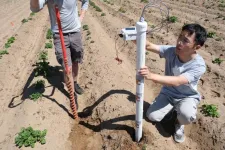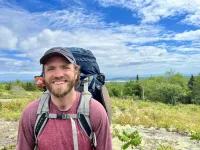(Press-News.org) MADISON — University of Wisconsin–Madison engineers have developed low-cost sensors that allow for real-time, continuous monitoring of nitrate in soil types that are common in Wisconsin. These printed electrochemical sensors could enable farmers to make better informed nutrient management decisions and reap economic benefits.
“Our sensors could give farmers a greater understanding of the nutrient profile of their soil and how much nitrate is available for the plants, helping them to make more precise decisions on how much fertilizer they really need,” says Joseph Andrews, an assistant professor of mechanical engineering at UW–Madison who led the research. “If they can buy less fertilizer, the cost savings could be quite significant at large-acreage farms.”
While nitrate is an essential nutrient for growing crops, excess nitrate can leach out of soil and into groundwater. This type of pollution is dangerous for people who drink contaminated well water and is harmful for the environment. The researchers’ new sensors could also be used as an agricultural research tool to monitor nitrate leaching and help guide best practices for mitigating its harmful effects.
Current methods for monitoring nitrate in the soil are laborious, expensive and don’t provide real-time data. That’s why Andrews, an expert in printed electronics, and his team set out to create a better and less costly solution.
For this project, the researchers used an inkjet printing process to fabricate potentiometric sensors, a type of thin-film electrochemical sensor. Potentiometric sensors are commonly used to accurately measure nitrate in liquid solutions. However, these sensors aren’t typically suitable for use in soil environments, where coarse soil particles will scratch them and interfere with obtaining accurate measurements.
“The main challenge we were trying to solve is figuring out a way to enable these electrochemical sensors to work well in the harsh environment of soil and accurately sense nitrate ions,” Andrews says.
The team’s solution was to place a layer over the sensor made from polyvinylidene fluoride. Andrews says this material has two key features. First, it has very tiny pores, about 400 nanometers in size, that allow nitrate ions to pass through while blocking soil particles. Second, it’s hydrophilic, meaning it attracts water and acts like a sponge to absorb it.
“So, any nitrate-laden water gets preferentially soaked into our sensor, and this is really important because soil also acts like a sponge, and you’re going to have a losing battle for getting moisture to come to your sensor unless you can match the water absorption potential of soil,” Andrews says. “These features of the polyvinylidene fluoride layer enable us to extract the nitrate-laden water, get it to the surface of our sensor and accurately sense nitrate.”
The researchers detailed their advance in a paper published in March 2024 in the journal Advanced Material Technologies.
The team has tested its sensors in two different soil types that are relevant for Wisconsin — sandy soil, which is common in the north-central part of the state, and silt loam soil, which is common in southwestern Wisconsin — and found that the sensors produced accurate results.
The researchers are now incorporating their nitrate sensors into a multifunctional sensing system they call a “sensing sticker,” in which three different kinds of sensors are mounted on a flexible plastic surface with an adhesive on the back. These stickers also contain moisture and temperature sensors.
The researchers will attach several sensing stickers to a rod, positioning them at different heights, and then bury the rod in the soil. This setup allows them to take measurements at multiple depths in the soil.
“By measuring the nitrate, moisture and temperature at different depths, we can now quantify the process of nitrate leaching and capture how nitrate is moving through the soil, which hasn’t been possible before,” Andrews says.
In summer 2024, the researchers plan to conduct further testing with their sensors by deploying 30 sensing rods in the soil at UW–Madison’s Hancock Agricultural Research Station and Arlington Agricultural Research Station.
The researchers are patenting their technology through the Wisconsin Alumni Research Foundation.
UW–Madison co-authors on the paper include Kuan-Yu Chen, Aatresha Biswas, Shuohao Cai, and Jingyi Huang, a professor of soil science.
This research was supported by the USDA Agriculture and Food Research Initiative Foundational Program (project no. WIS04075), the National Science Foundation Signals in the Soil grant 2226568, and the University of Wisconsin–Madison Dairy Innovation Hub.
###
--Adam Malecek, acmalecek@wisc.edu
END
Growing up in neighborhoods with more educational and socioeconomic opportunities has a positive impact on infants’ brain activity, according to new research from Boston Medical Center (BMC). The study, published in The Journal of Developmental & Behavioral Pediatrics, suggests that enhancing neighborhood opportunities, particularly in education, can be a promising approach to promoting early childhood development.
A team of early childhood researchers examined how neighborhood opportunity – the socioeconomic, educational, health, and ...
WEST LAFAYETTE, Ind. — Across the Midwest during the warmer months, studying the sky for signs of storms and tornadoes becomes one of the most popular pastimes.
Dan Chavas, an associate professor in the Department of Earth, Atmospheric, and Planetary Sciences at Purdue University’s College of Science, takes it further: All day every day, he studies what makes tornadoes tick. Working at the intersection of climate science and meteorology, he looks at the big picture of what causes severe storms and tornadoes — and what dictates where ...
Philadelphia, June 27, 2024 – Researchers from Children’s Hospital of Philadelphia (CHOP) found that young children between the ages of 5 and 12 were more likely to experience a concussion from recreation and other non-sport activities, yet those injuries were not seen by specialists until days later compared with sports-related concussions in the same age group.
This study suggests concussion research is needed for children outside of sports and that providing more resources and education ...
A common algorithm to check for endometrial cancer is not reliable for Black women, according to a new study published today in JAMA Oncology.
In Black patients with concerning symptoms, a tissue biopsy is strongly recommended to rule out endometrial cancer instead of using transvaginal ultrasound, the report concluded.
Endometrial cancer is the most common type of gynecological cancer in the United States. It is one of the few types of cancer now on the rise, especially among Black women, who are more likely to be diagnosed at later stages of the disease. This cancer can cause symptoms such as abnormal vaginal ...
· Black participants with greater access to green spaces had up to 35% lower odds of calcification
· Black participants living near a river had 32% lower odds of calcification
· Coronary artery calcification is an early sign of cardiovascular disease
CHICAGO --- Being near and having more exposure to urban green space and blue (water) space is linked to lower odds of having coronary artery calcification in middle age, which is an early marker of cardiovascular disease.
The associations were more pronounced among Black individuals and those living in neighborhoods ...
Compared to straight and cisgender individuals, sexual and gender minority adults in the US are more likely to face barriers paying for or accessing adequate health insurance and healthcare, but few states collect sexual and gender identity (SOGI) information to better understand the health challenges and needs of this population. To close this knowledge gap, the Centers for Medicare & Medicaid Services (CMS) added three optional SOGI questions to its model application, with guidance for states that choose to incorporate the questions into their Medicaid and Child Health Insurance ...
MADISON–In a rare opportunity to study carnivores before and after wolves were reintroduced to their ranges, researchers from the University of Wisconsin–Madison found that the effects of wolves on Isle Royale have been only temporary. And even in the least-visited national park, humans had a more significant impact on carnivores’ lives.
The paper, published recently in Frontiers in Ecology and the Environment, uses DNA from foxes and martens’ scat and hair to understand where these animals were and what they ...
COLUMBIA, Mo. ― Researchers from the University of Missouri School of Medicine found that a targeted gene therapy may make acute myeloid leukemia (AML) more sensitive to chemotherapy, while also protecting the heart against toxicity often caused by cancer treatments.
Acute myeloid leukemia is the most common type of leukemia in adults and the resulting chemotherapy treatment can put patients at an increased risk for cardiac damage. Associate Professor of Medicine Dr. Xunlei Kang and PhD students Yi Pan and Chen Wang led a study looking at similarities between leukemia and cardiovascular disease. They found a shared target -- AGTR1, ...
UNIVERSITY PARK, Pa. — The availability and adoption of high-speed broadband appears to boost the number of farms offering agritourism activities, according to a new study led by Penn State researchers. Their findings, the researchers said, bolster the argument for expanding broadband availability in support of farm operators who want to benefit from the growing consumer interest in on-farm experiences.
“Agritourism operations are consumer-facing businesses that offer activities to farm or ranch visitors, such as farm stands, pumpkin patches, corn mazes, hayrides and ...
URBANA, Ill. -- LGBTQ+ people involved in farm work are over three times more likely to experience depression and suicidal intent and about two and a half times more likely to experience anxiety than the general population. That’s according to a new study led by farmer mental health experts at the University of Illinois Urbana-Champaign.
“For several years, I've done work around farm stress and mental health among farmers in general. We’ve found people who work in agriculture have adverse mental health compared to those who work in other areas. Similarly, there are findings that queer folks have worse mental health than their ...



